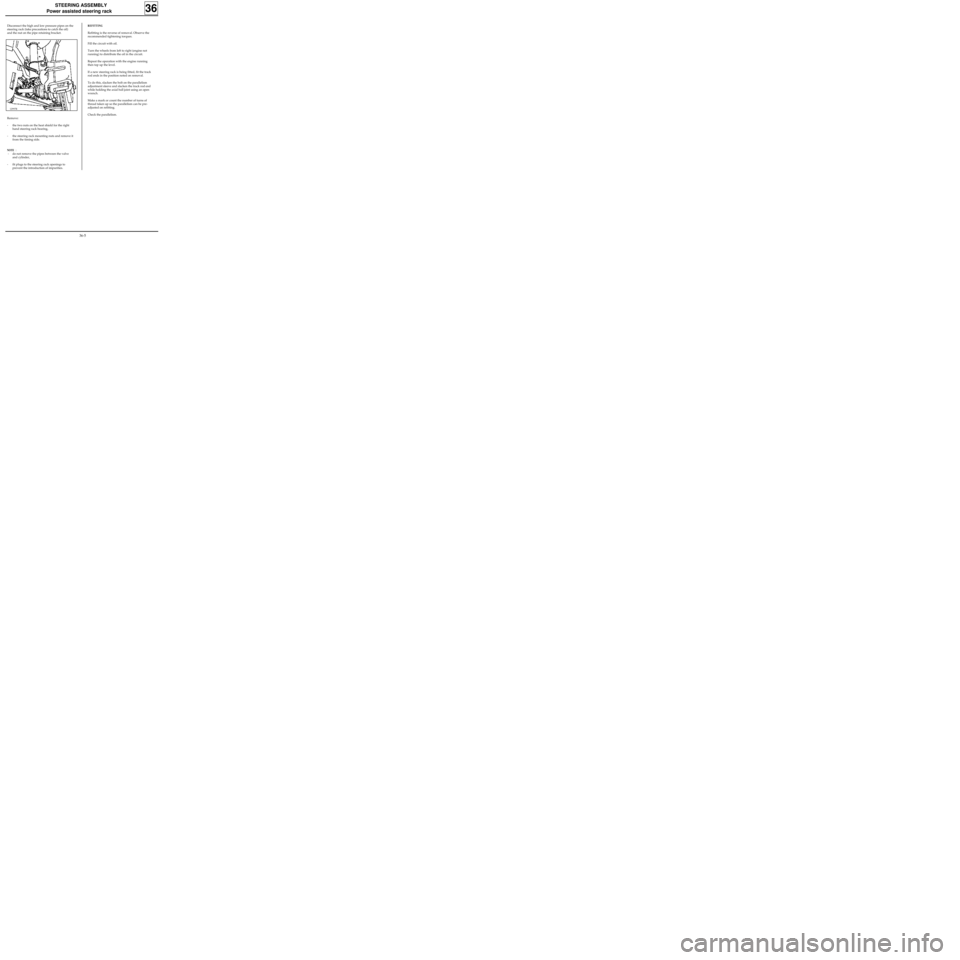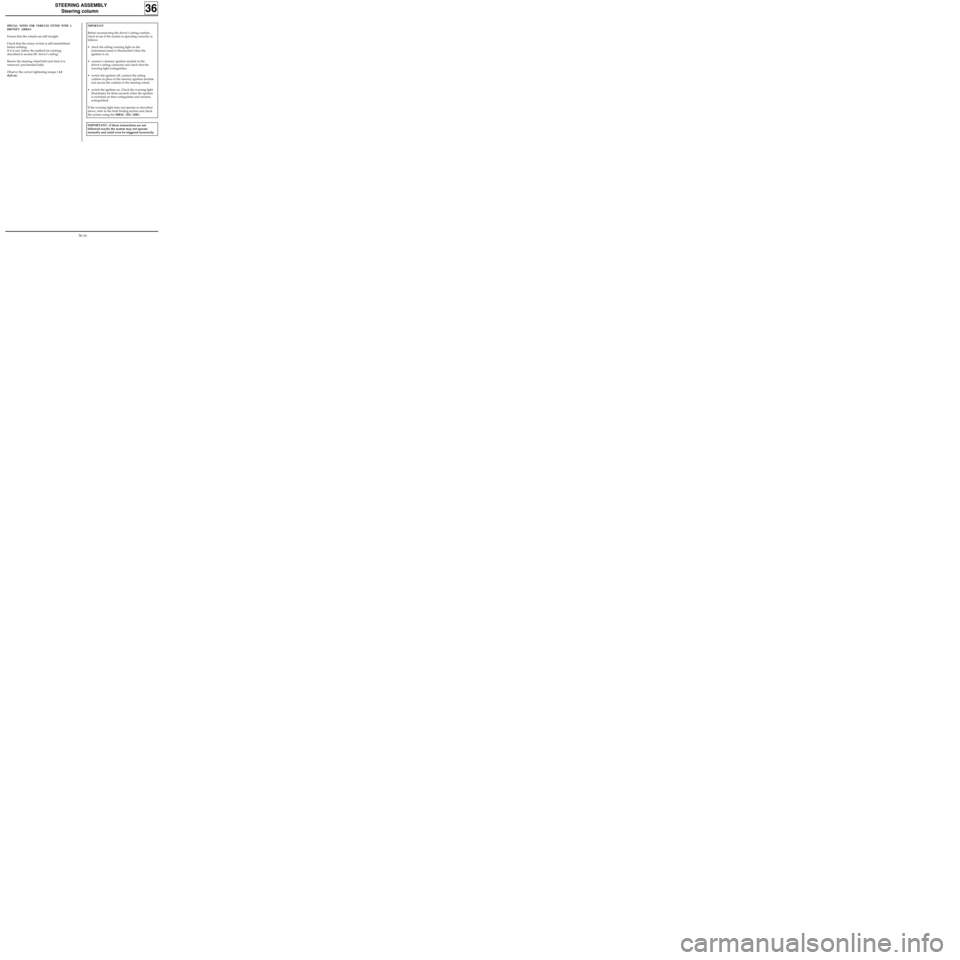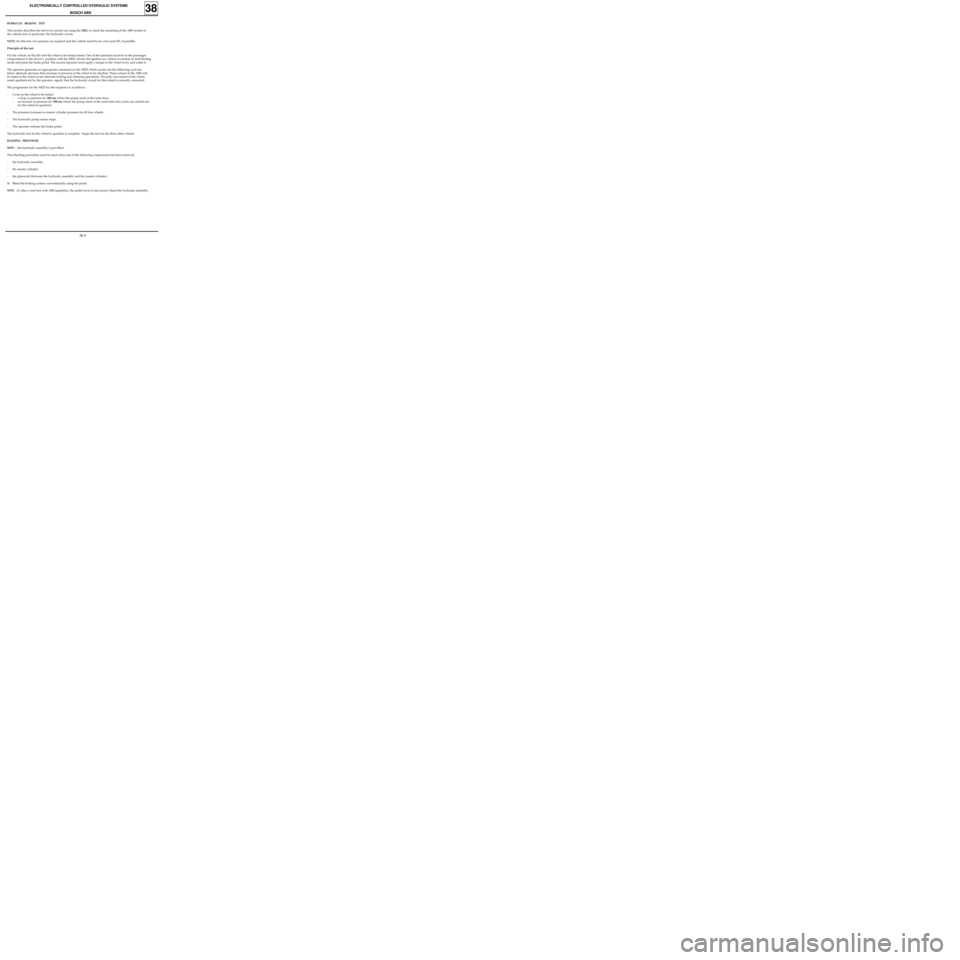1997 RENAULT KANGOO wheel torque
[x] Cancel search: wheel torquePage 57 of 105

STEERING ASSEMBLY
Power assisted steering rack
36
Disconnect the high and low pressure pipes on the
steering rack (take precautions to catch the oil)
and the nut on the pipe retaining bracket.
Remove:
- the two nuts on the heat shield for the right
hand steering rack bearing,
- the steering rack mounting nuts and remove it
from the timing side.
NOTE :
- do not remove the pipes between the valve
and cylinder,
- fit plugs to the steering rack openings to
prevent the introduction of impurities.
12997R
REFITTING
Refitting is the reverse of removal. Observe the
recommended tightening torques.
Fill the circuit with oil.
Turn the wheels from left to right (engine not
running) to distribute the oil in the circuit.
Repeat the operation with the engine running
then top up the level.
If a new steering rack is being fitted, fit the track
rod ends in the position noted on removal.
To do this, slacken the bolt on the parallelism
adjustment sleeve and slacken the track rod end
while holding the axial ball joint using an open
wrench.
Make a mark or count the number of turns of
thread taken up so the parallelism can be pre-
adjusted on refitting.
Check the parallelism.
36-5
Page 64 of 105

STEERING ASSEMBLY
Steering column
36
TIGHTENING TORQUES (in daN.m)
REMOVAL
Disconnect the battery.
Set the vehicle wheels straight.
Remove the steering wheel in the following
manner.
Without airbag option
Remove the plastic cover.
Remove:
- the steering wheel bolt (this
MUST be renewed
on refitting),
- the steering wheel after noting its position.
With airbag option
REMOVAL
Disconnect the battery.
Remove:
- the driver’s airbag cushion by the two Torx T30
bolts (tightening torque 0.5 daN.m) located
behind the steering wheel and disconnect the
connector ( D ),
IMPORTANT: pyrotechnic systems (airbags and
pretensioners) must not be handled near to a heat
source or flame - they may be triggered.
IMPORTANT : whenever the steering wheel is
removed, the airbag connector ( D )
MUST be
disconnected. The airbag is fitted with a
connector which short circuits when it is
connected to avoid any incorrect triggering.
12973S
- the horn connector, if fitted,
- the steering wheel bolt (this
MUST be renewed
on refitting),
- the steering wheel after setting the wheels
straight,
- the half cowlings ( three bolts).
Disconnect the rotary switch connector and
remove it after removing the three mounting
bolts ( E ).
When removing the switch, its position must be
noted:
• either by ensuring the wheels are straight when
removing it so that the track may be positioned
centrally,
• or by immobilising the rotary switch rotor with
adhesive tape.
Steering wheel bolt 4.5
Steering column universal joint
eccentric bolt 2.5
Steering column mounting nuts 2
36-12
Page 68 of 105

STEERING ASSEMBLY
Steering column
36
IMPORTANT : if these instructions are not
followed exactly the system may not operate
normally and could even be triggered incorrectly.
IMPORTANT
Before reconnecting the driver’s airbag cushion,
check to see if the system is operating correctly as
follows:
•check the airbag warning light on the
instrument panel is illuminated when the
ignition is on,
•connect a dummy ignition module to the
driver’s airbag connector and check that the
warning light extinguishes,
•switch the ignition off, connect the airbag
cushion in place of the dummy ignition module
and secure the cushion to the steering wheel,
•switch the ignition on. Check the warning light
illuminates for three seconds when the ignition
is switched on then extinguishes and remains
extinguished.
If the warning light does not operate as described
above, refer to the fault finding section and check
the system using the
XRBAG (Elé. 1288).
SPECIAL NOTES FOR VEHICLES FITTED WITH A
DRIVER’S AIRBAG
Ensure that the wheels are still straight.
Check that the rotary switch is still immobilised
before refitting.
If it is not, follow the method for centring
described in section 88 "driver’s airbag".
Renew the steering wheel bolt each time it is
removed ( pre-bonded bolt).
Observe the correct tightening torque ( 4.5
daN.m).
36-16
Page 78 of 105

96118R
MECHANICAL ELEMENT CONTROLS
Brake pipes
37
These vehicles have brake pipes without a copper seal. The seal is by contact "at the bottom of the cone" of
the shoulder (Y) on the pipe.
X = 1.5
Z= 1.3
TIGHTENING TORQUES (in daN.m)
PRECAUTIONS TO BE TAKEN WHEN REMOVING - REFITTING A BRAKE CYLINDER OR A BRAKE PIPE.
For safety reasons and to ensure that the brake pipe is not twisted and is not liable to touch a suspension
component the following order of operations must be observed:
Remove the hose from the caliper and if necessary
remove the caliper.
REMOVAL
Slacken the union (1) (pipe wrench) between the
rigid pipe and the hose (2) until the spring (3)
becomes slack which releases the hose from the
splines (4).
85536R
REFITTING
Fit the caliper to the brake and screw the hose
onto it, then torque tighten to
1.5 daN.m.
The brake pipes are fitted when the axle assembly
is in position:
• Wheels suspended (suspension in place)
• Axle assembly aligned (wheels straight)
Position the female end of the hose on the
retaining bracket (5), without twisting it and
check that the end piece (4) fits freely into the
splines of the bracket, then fit:
- the spring (3),
- the rigid pipe to the hose, checking that the
hose does not turn when the assembly is
screwed together.
Torque tighten the union.
Bleed the brake circuit.
37-10
Page 80 of 105

MECHANICAL ELEMENT CONTROLS
Braking compensator
37
NOTE
the braking compensators differ depending on the type of rear axle:
-standard load rear axle: red reference mark,
-increased load rear axle: green reference mark,
REMOVAL
Put the vehicle on a two post lift.
Disconnect the brake pipes.
Disconnect rod ( 2 ) from the compensator by
slackening bolt ( 1 ).
Remove the compensator (two bolts).
12865-1R
TIGHTENING TORQUES (in daN.m)
Hydraulic unions 1.7
Compensator mounting bolt 1.8
Rod adjustment bolt 1
NOTE : do not alter the position of nut (3).
REFITTING
Refitting is the reverse of removal.
Bleed and check the circuit (see section "Checking
- Adjusting").
SPECIAL TOOLING REQUIRED
Fre. 244 -03
or
Fre. 1085-01
CHECKING
Connect two pressure gauges Fre. 244-03 or
Fre. 1085-01 :
- one at the front right hand side,
- one at the rear left hand side.
Bleed the pressure gauges via screw (P).
98828R
Progressively press the brake pedal until the
pressure at the front wheels is the setting
pressure (see table of values). Read the
corresponding pressure at the rear wheels;
correct it if necessary.Pressure gauge for checking
compensator rating
37-12
Page 103 of 105

ELECTRONICALLY CONTROLLED HYDRAULIC SYSTEMS
BOSCH ABS
38
13138R
Pipe unions M10 × 100 1.7
M12 × 100 1.7
TIGHTENING TORQUES (in daN.m)
REMOVAL
Put the vehicle on a two post lift.
Disconnect the battery.
Remove the front right hand wheel.
Fit a pedal press to limit the amount of brake
fluid which will run out.
From above:
Disconnect the computer connector.
Remove the two earth bolts.
Disconnect the six pipes from the hydraulic assem-
bly, marking their position for refitting.
From below:
Remove:
- the exhaust downpipe,
- the exhaust manifold heat shield ( 3 bolts),
- the two lower mounting bolts for the hydraulic
assembly,HYDRAULIC ASSEMBLY
13139R
- the hydraulic assembly via the wheel arch.
Remove the upper hydraulic assembly mounting
bolt ( 1 ).
REFITTING
Refitting is the reverse of removal.
NOTE : the computer must not be removed. If
there is a fault, replace the complete hydraulic as-
sembly.
38-8
Page 104 of 105

ELECTRONICALLY CONTROLLED HYDRAULIC SYSTEMS
BOSCH ABS
38
HYDRAULIC BRAKING TEST
This section describes the test to be carried out using the XR25, to check the mounting of the ABS system in
the vehicle and, in particular, the hydraulic circuit.
NOTE: for this test, two persons are required and the vehicle must be on a two post lift, if possible.
Principle of the test
Put the vehicle on the lift with the wheel to be tested raised. One of the operators must be in the passenger
compartment in the driver’s position with the XR25. Switch the ignition on, vehicle in neutral, in fault finding
mode and press the brake pedal. The second operator must apply a torque to the wheel to try and rotate it.
The operator generates an appropriate command on the XR25 which carries out the following cycle ten
times: alternate decrease then increase in pressure at the wheel to be checked. These actions in the ABS will
be noted at the wheel as ten alternate locking and releasing operations. The jerky movement of the wheel,
noted qualitatively by the operator, signify that the hydraulic circuit for this wheel is correctly connected.
The programme for the XR25 for this sequence is as follows:
- Cycle on the wheel to be tested:
- a drop in pressure for 200 ms where the pump starts at the same time,
- an increase in pressure for 300 ms where the pump starts at the same time (ten cycles are carried out
for the wheel in question).
- The pressure increases to master cylinder pressure for all four wheels.
- The hydraulic pump motor stops.
- The operator releases the brake pedal.
The hydraulic test for the wheel in question is complete - begin the test for the three other wheels.
BLEEDING PROCEDURE
NOTE :
the hydraulic assembly is pre-filled.
This bleeding procedure must be used when one of the following components has been removed:
- the hydraulic assembly,
- the master cylinder,
- the pipework (between the hydraulic assembly and the master cylinder).
1)Bleed the braking system conventionally using the pedal.
NOTE : if, after a road test with ABS regulation, the pedal travel is not correct, bleed the hydraulic assembly.
38-9